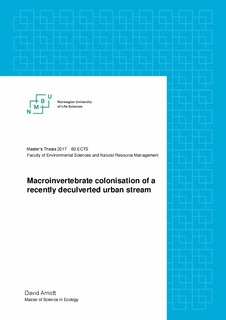| dc.description.abstract | Historically, when urban land has been developed, stream burial has been a common practice. Today, many urban communities, including the city of Oslo, are increasingly attempting to restore buried streams through deculverting. In addition to ecological and aesthetical improvements, deculverting may also be an effective management method for the removal of nutrients. However, it is largely unknown how species assemblages and ecosystems in such newly created streambeds develop and function. This thesis investigates the first year following a deculverting project in the stream Hovinbekken in Oslo, Norway. In order to determine how macroinvertebrates colonise newly created streambeds, samples were collected monthly from May to November in 2016, from six sites within the restored reach and one upstream reference site. Water chemistry samples were also taken. Similar macroinvertebrate samples were collected along a gradient of increasing urbanisation from the urban stream Akerselva. Results from Hovinbekken showed that all species found in the restored reach were also found at the reference site. The upper restored sites had both higher family richness and larger population sizes compared to downstream restored sites. They also had the species assemblages in the restored reach most closely resembling that of the reference site. This is suggestive that the initial colonisation by macroinvertebrates occurred primarily via drift and depended on the species assemblage upstream of the restored site as a source of colonists. Family assemblage comparisons using NMDS ordination between Hovinbekken and Akerselva indicated that the reference site had a similar assemblage to the lower urbanised reaches of Akerselva, suggesting the local species pool was limited to that of a highly urbanised stream. The initial colonists were those with high pollution tolerances, as indicated by low ASPT scores, and consisted mainly of Chironomidae and Oligochaeta. This indicated that the restored reach was affected by organic pollutants. Water chemistry showed that in the growing season, the restored reach removed nitrogen and phosphorus, while in autumn, nutrient demand declined and nutrients were released. This suggests that such restored systems may, for part of the year, remove nutrients from polluted water and function as natural water purification facilities. Based on these results, the success of restoration projects where the objective is to increase biodiversity depends on whether potential colonisers are able to disperse to the restored site, and whether there is a local species pool to disperse from. In addition, stressors in the environment, such as organic pollutants, may negatively impact successful colonisation. | |

